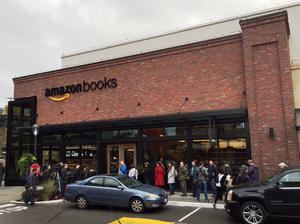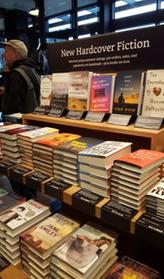 Isn't it ironic that Amazon started 20 years ago offering the millions of titles a physical bookstore couldn't, and its first bookstore has mere thousands of titles on its shelves? The newly opened Amazon Books is a small space that stocks fewer titles than most other bookstores. It is sleek and elegant, and its literal bricks-and-mortar façade fits nicely in the upscale University Village neighborhood. But at its grand opening, the store seems to have embraced the showroom culture that the company initially developed by foisting it upon competitors.
Isn't it ironic that Amazon started 20 years ago offering the millions of titles a physical bookstore couldn't, and its first bookstore has mere thousands of titles on its shelves? The newly opened Amazon Books is a small space that stocks fewer titles than most other bookstores. It is sleek and elegant, and its literal bricks-and-mortar façade fits nicely in the upscale University Village neighborhood. But at its grand opening, the store seems to have embraced the showroom culture that the company initially developed by foisting it upon competitors.
With news cameras rolling, the store opened at 9:30 a.m. yesterday, after a line had formed outside. When the doors opened, a handful of people applauded, several of whom turned out to be Amazon employees.

In the Seattle Times report on the store's opening, Jennifer Cast, v-p of Amazon Books, stated that "we felt sorry for the books that were spine out" in other stores. The solution? Stock fewer titles, effectively eliminating those that would have been spine-out at more robust bookshops.
Titles from the many imprints Amazon publishes are represented on the shelves, though not prominently or overwhelmingly. Notably, Penny Marshall's memoir My Mother Was Nuts--which Amazon reportedly paid $800,000 to publish--couldn't be found. For titles the store doesn't stock, customers are encouraged to "check out our website."

In every way, Amazon has tried to package its online experience into a bricks-and-mortar retail outlet, begging the question, why? For book lovers, the appeal of exploring a favorite bookstore or a new one is the adventure of finding something you might not have discovered otherwise. Readers like to spend hours even in a small bookstore and still walk away feeling like there is more to see next time. With its small inventory and clinical approach to a bookshop aesthetic, Amazon Books fails to cultivate that atmosphere of endless possibility. After an hour, you've seen it all. For all the fanfare about Amazon's first physical bookshop, Amazon customers might soon realize that it's just easier to get it online. --Dave Wheeler

